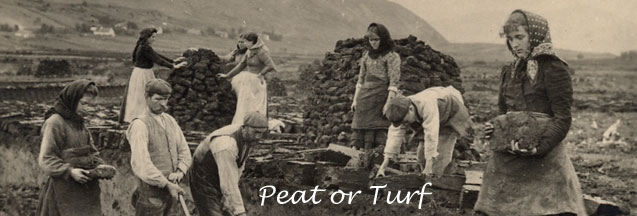

|
| WALSH/LANGAN INTRODUCTION - HOME PAGE |
| Turf or Peat
| |
|
Peat is an organic fuel formed by the accumulation and partial decomposition of vegetable matter in areas where the climate is wet and mild, and the drainage is poor. Peat deposition is the first step in the formation of coal. If the climate was drier the peat would decompose further. As it is, the moisture in the ground does not allow the vegetable matter to completely decompose. Peatland or bogland covers about 15% of Ireland. There are large expanses of "blanket" bog in County Mayo. Peat in its natural state is 90 to 95 per cent water. In the summer time peat or "turf" is cut into blocks with a spade and set in stacks to dry. When dry, the blocks weigh from three quarters of a pound to two pounds each. Dried peat burns easily with a smoky flame and a very distinct (and pleasant) odor. Peat was the source of heating and cooking in Ireland for centuries. It was also harvested and used in many parts of Germany. The following pictures depict the cutting, drying, carrying and selling of "turf" or peat in Ireland. Turf burns without tending and remains lit even if moved. When we were in Ireland in 2000, every pub we went into had a peat fire and we could smell the pleasant aroma of burning peat everywhere we went. Alas, on our trip in June 2004 most of the pubs had artificial fires (if they had any at all) and while you could frequently smell a peat fire it was not as common as it had been just four years before. In September 2007 Robert McLoughlin wrote about the changes in the frequency of the peat fires in pups, "One of the possibilities could be a change in pub ownership. For instance if a pub is family run it is much more likely to have a real fire - a family member will tend the fire etc. A pub that is owned by business partners will be more 'efficiently' run - a fire is to labour intensive (my brother owns a pub and can't get his staff to keep it going when the place is busy). | |
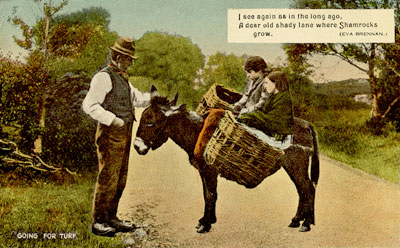
|
"Going for Turf"
No postmark. |
| Postcard collection of Maggie Land Blanck | |

|
Cutting the turf
|
| From a 1948 guide to Connacht, book collection of Maggie Land Blanck | |
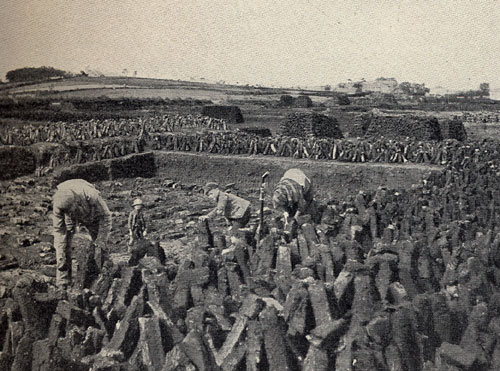
|
Cuttin and stacking turf
|
| Stoddard lectures Ireland, 1901 | |
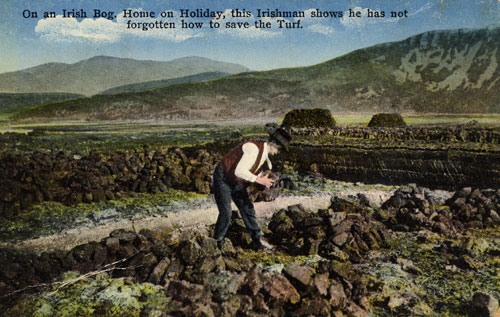
|
On an Irish bog. Home on Holiday, this
Irishman shows he has not forgotten how to save the Turf.
Not posted |
| Postcard collection of Maggie Land Blanck | |

| |
| Photo collection of Maggie Land Blanck | |
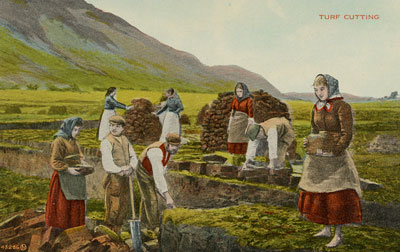
|
"Turf Cutting"
This postcard was clearly based on the above picture. No postmark |
| Postcard collection of Maggie Land Blanck | |
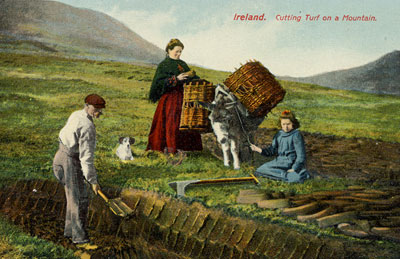
|
"Ireland. Cutting Turf on a Mountain"
No postmark. |
| Postcard collection of Maggie Land Blanck | |
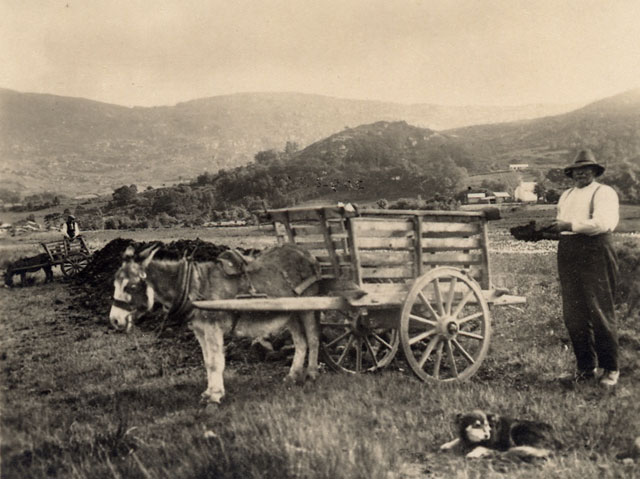 | |
| Photo collection of Maggie Land Blanck | |
| "Gathering the turf" | |
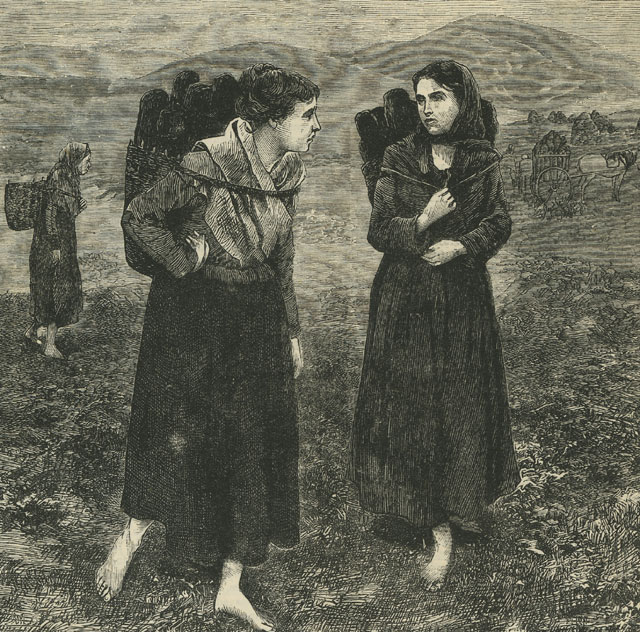 |
|
| Frank Leslie's Popular Monthly, April 1880, collection of Maggie Land Blanck | |
| "Turf Gatherers" | |
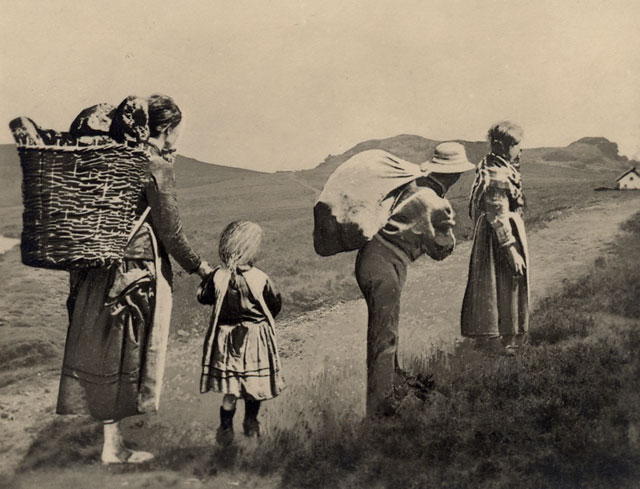
| |
| Postcard collection of Maggie Land Blanck
| |
| "Bringing Home the Turf" | |
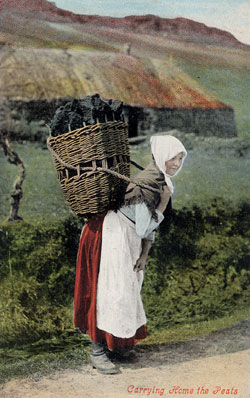
|
"Carrying Home the Peats"
No postmark |
| Postcard collection of Maggie Land Blanck | |
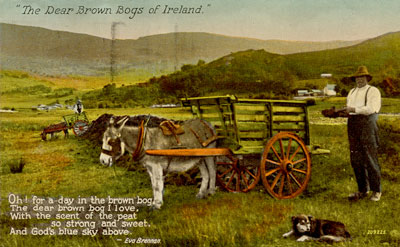
|
"The Dear Brown Bogs of Ireland"
Postmarked 1939 This card was clearly based on the above photo. |
| Postcard collection of Maggie Land Blanck | |
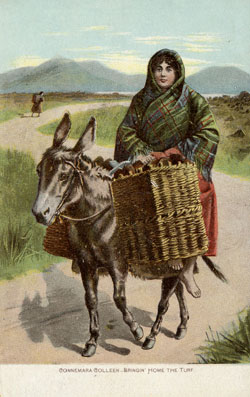
|
"Connemara Collen- Bringing home the turf" |
| Postcard collection of Maggie Land Blanck
| |
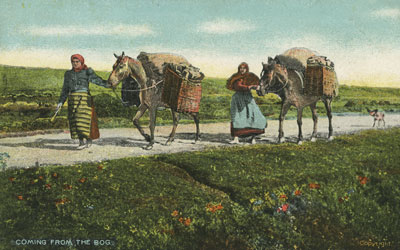
| |
| Postcard collection of Maggie Land Blanck
| |
| "Coming form the bog" | |
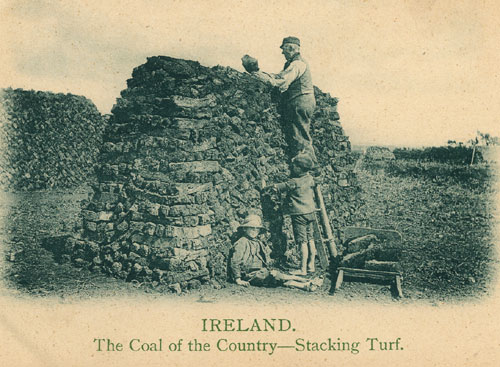
|
The coal of the Country-Stacking Turf
Not posted |
| Photo collection of Maggie Land Blanck, 2004 | |
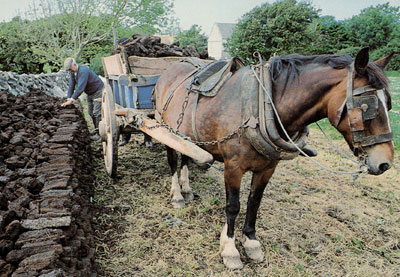
|
"Stacking the turf for winter"
No postmark |
| Postcard collection of Maggie Land Blanck | |
|
||
The picture on the left shows the surface of the bog. The picture on the right, shows the dark brown layer of peat. | ||
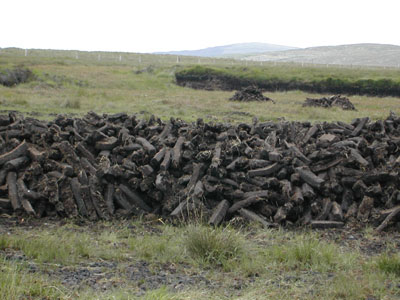
|
Stacked turf
|
| Photo collection of Maggie Land Blanck, 2004 | |
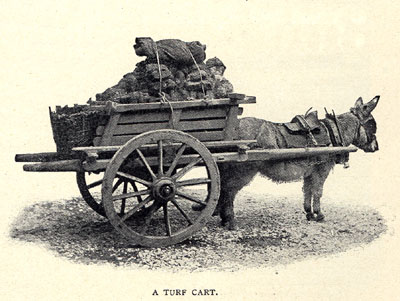
| "A Turf Cart" |
| Stoddard lectures on Ireland 1901
| |
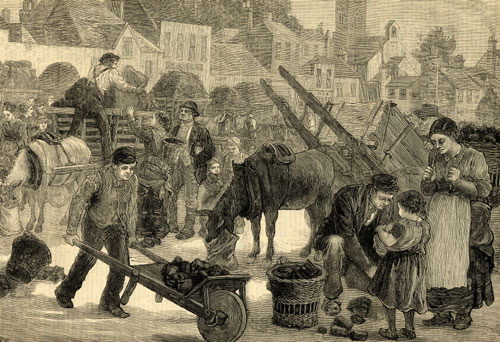
| |
| Print collection of Maggie Land Blanck
| |
| Irish Sketches:Turf Market in the South of Ireland from the Illustrated London News, January 24, 1880 | |
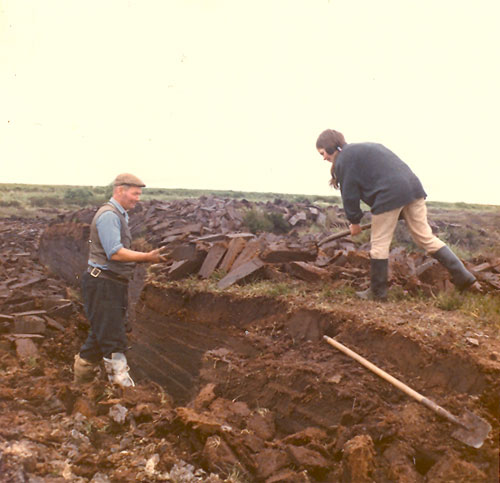
| |
| Photo courtesy of Christine Twycross
"Bridey and her Da cut the turf. I took the photo in 1973, but I do not remember exactly where in Ireland, just the name of the girl." | |
| Selling Turf during World War II In December 2015 James J Bunyan wrote to me about his friend Michael Kelly whose father, "John Joe Kelly was actively involved in the production of turf and it supply to shops in Limerick and Tipperary during the years of World War 2." James added about his own father: "My father bought 2 lorries and became a turf supplier - probably hauling the turf from the bogs and storage places in North Kerry to shops in East Limerick and elsewhere. I remember being with my father in Old Pallas in East Limerick in the late 1940's or in the early 1950's. I attach copy of text of letter, which Mr. Leonard, shopkeeper Ballyhooldy (not far from Fermoy, where I live) sent to my father in early January 1944."The letter: BallyhoolyThe following excerpt was taken from James's article on Turf Activity and 1943 General Election Nostalgia: "It was inevitable that commercial turf activity would play a significant role in the 1943 General Election. The economy in North and South Kerry in that era was all about cutting, saving and selling turf to earn money to survive and to keep the home fires burning. | |
| If you have any suggestions, corrections, information, copies of documents, or photos that you would like to share with this page, please contact me at maggie@maggieblanck.com |
| The Potato and Other Crops | |||
| Houses | |||
| The People | Transportation | JOHN WALSH | |
| MATHIAS LANGAN | |||
| WALSH/LANGANS INTRODUCTION | |||
| HOME PAGE | |||
| Irish Life | |||
| Please feel free to link to this web page. You may use images on this web page provided that you give proper acknowledgement to this web page and include the same acknowledgments that I have made to the provenance of the image. Please be judicious. Please don't use all the images. You may quote original text from this web page and use any cited quotes on this web page provided you give proper acknowledgement to this web page and include the same acknowledgments that I have made to the provenance of the information. Please do not cut and paste the whole page. You may NOT make use any of the images or information on this web page for your personal profit. You may NOT claim any content of this web page as your original idea. Thanks, Maggie |
| This page was created in 2004: Latest update January 2016 |